Biography of Asahel and Lelah Hockett
Our second narrative is the story of Dr. Asahel Hockett and Lelah Hockett who lived an eventful life. It soared from national recognition in medicine to ending in small rural clinics far from the limelight. Their story goes from the heights of the medical world to the depths of personal tragedy.
The first time I remember meeting Uncle Asahel was when he came out to the ranch around 1950 when I was very young and diagnosed me with pneumonia. I still remember him coming into the bunk bedroom where I slept with my brothers and thumping my chest with the stump of his middle and index fingers that were cut off short. It made for a effective tool to sound out the congestion in my chest. Asahel was a great diagnostician in that by just examining your body he could zero in on what was ailing you, without any sophisticated equipment, he was well known for this ability. However let’s go to the beginning and work our way through their lives.
Date of this photo is 1967, which means it probably wasn’t developed until Asahel passed away

Here is the family tree for Asahel’s parents. His mother was Grace Suiter, CT Hockett’s first wife, who died young.
Asahel’s parents
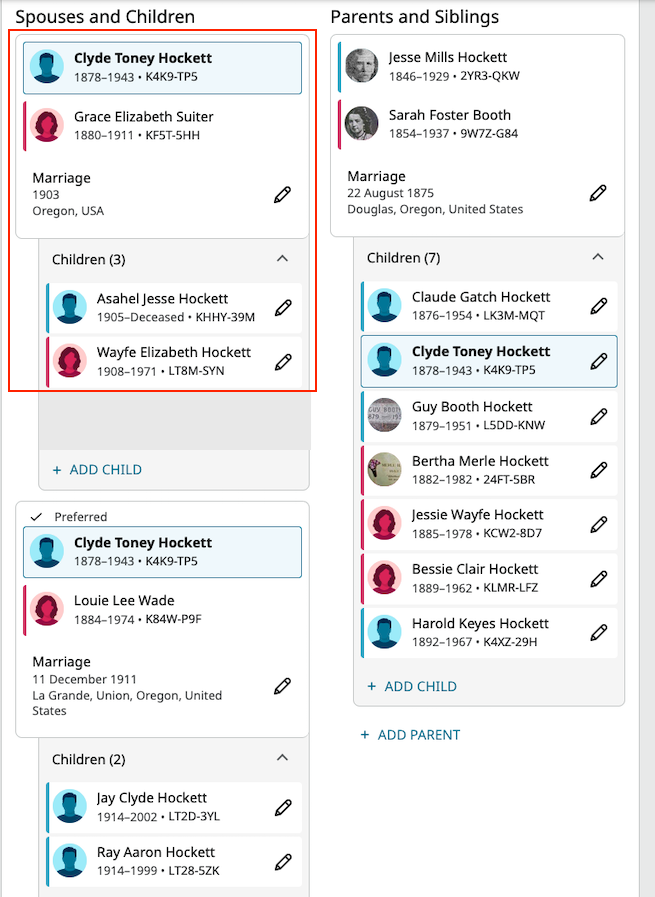
For Lelah Childers Hockett her roots are very entangled with another side of the family, the Bennett’s of which my mother Azalee Bennett Hockett is derived. Leah’s father was William F. Childers (who also was married to my grandmother Ethel L. Ryder, who earlier was married to a Bennett) and Lelah’s mother was Cora Morelock (one of 13 children!). Somewhere in there is a divorce and Lelah is raised as a teenager in Portland with her mother and stepfather and attends Girls Polytechnic High School in Portland. Confused now?
This tree will help, it shows how Azalee Bennett Hockett and Lelah Childers Hockett are related and how Lelah leaves Wallowa County and moves to Portland where she meets Asahel (or maybe they met on a mutual visit to the County) and they get married in Gresham, Oregon.
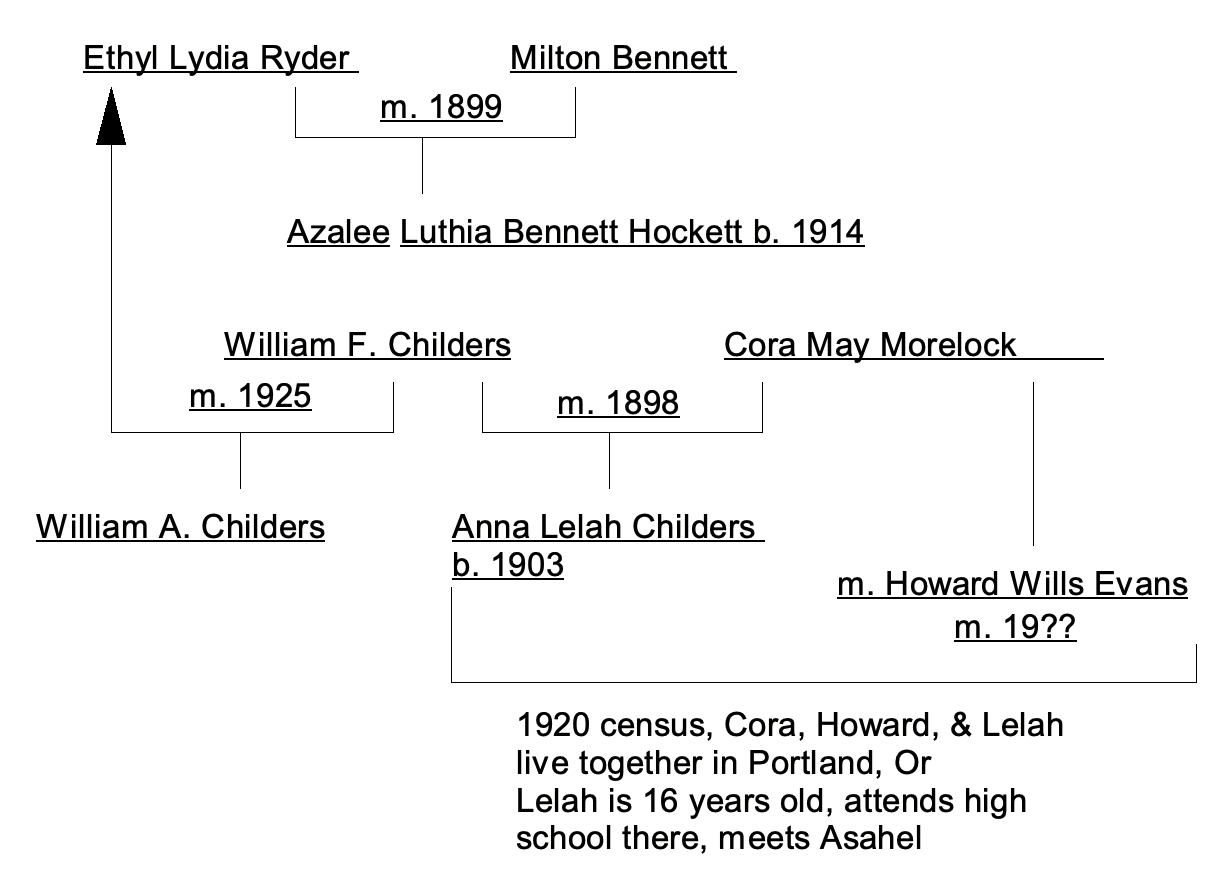
Lelah is an active student at Girls Polytechnic High School in Portland, being a class officer and also writing a section of the Portland Oregonian Newspaper on high school news.
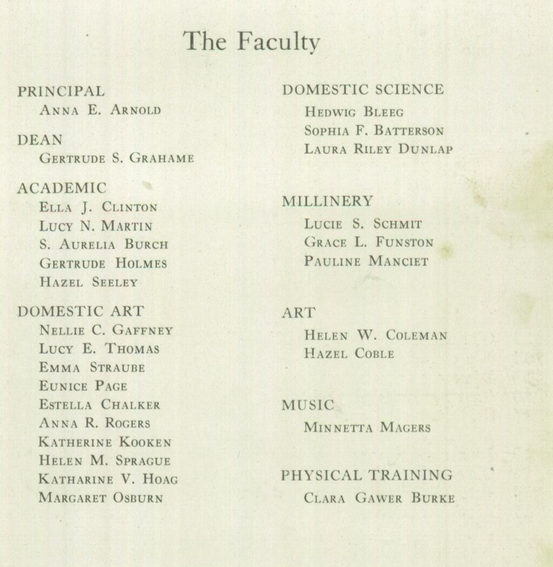
Lelah Graduates in 1920 from Girls Polytechnic High School in Portland and writes for the paper
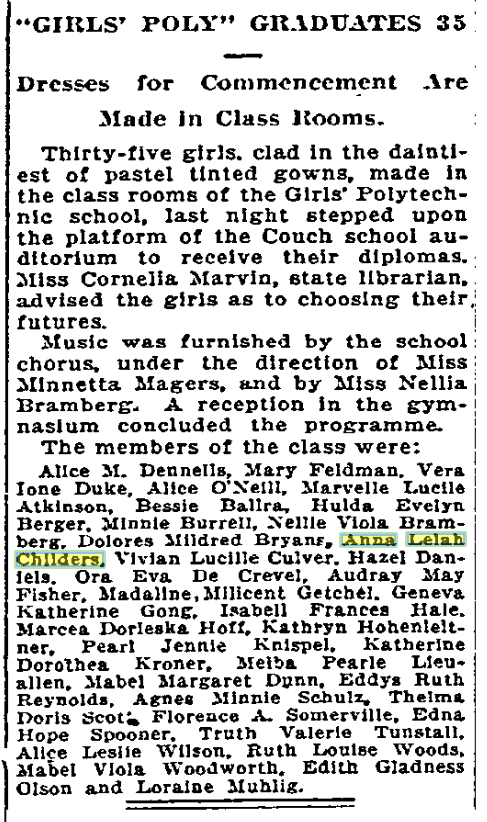

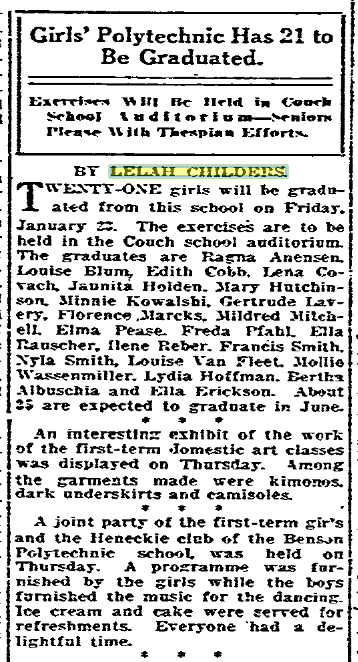
Lelah’s photo from Girls Polytechnic High School, 1920. Lelah is in the second row, far right. The article states “Ambitious young women will publish “The Polytechnic Maid” new girls school paper”
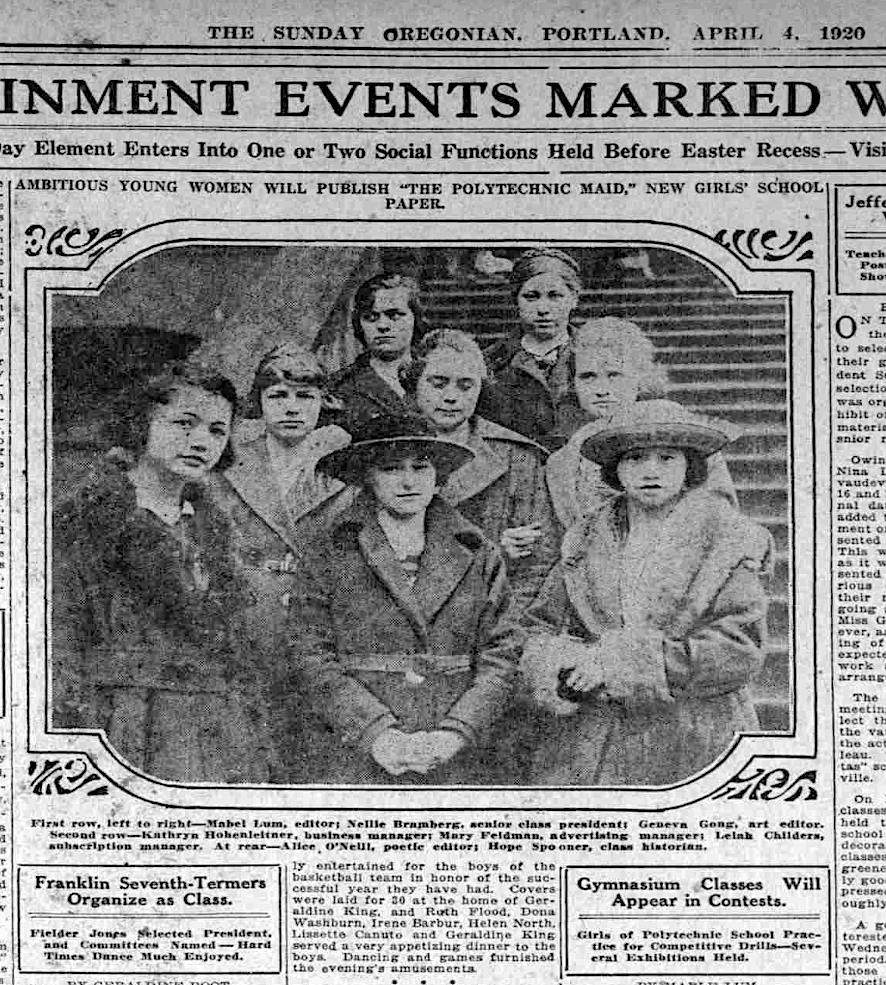
Lelah’s High School Building, 1920 (it was getting run down by then and was torn down)
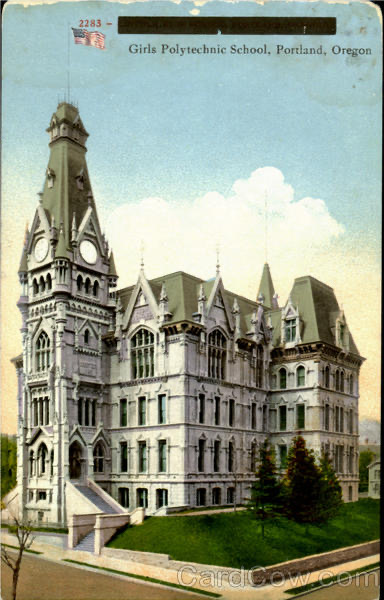
In 1925 Lelah climbs Mt. Hood, 11,249 ft high. Along with Lucille Morelock, a cousin on her mother’s side who was 22 years old. Adventurous women! The more we learn about Lelah the more intrigued we are.

Asahel graduated from Jefferson High School in Portland, Oregon in 192

Here is a a quote from Uncle Jay’s narrative about Asahel, Wayfe, and Vernon going to school in Portland instead of Wallowa County …
“We were all raised together as one family and when Ray and I were born, Vernon claimed Ray and Wayfe claimed me and we received special attention in this way. When Asahel, Wayfe, and Vernon reached high school age, however, they were sent to Portland to go to school as they believed the Portland schools to be superior. Asahel and Wayfe stayed with Aunt Wayfe and Uncle Jay and Vernon stayed with Earl and Fay. We missed them but ti was a big day when they returned home in the spring.”
Below is his graduation photo in 1929 from Oregon Medical School (he received is B.A. Degree from Oregon in 1926). His class was actually bigger than this (51 students). I believe they are instructors and special students of the class.
Asahel is at the far left with the typical Hockett face.
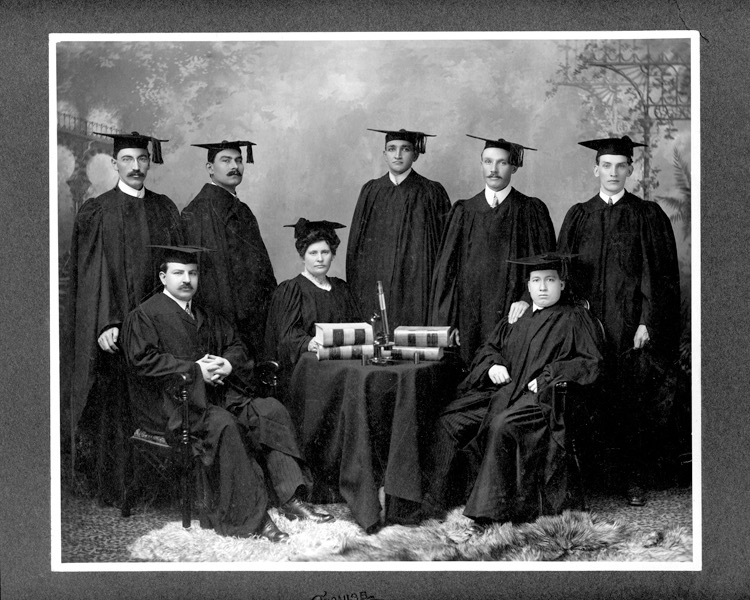
Full Graduation Class, 1929
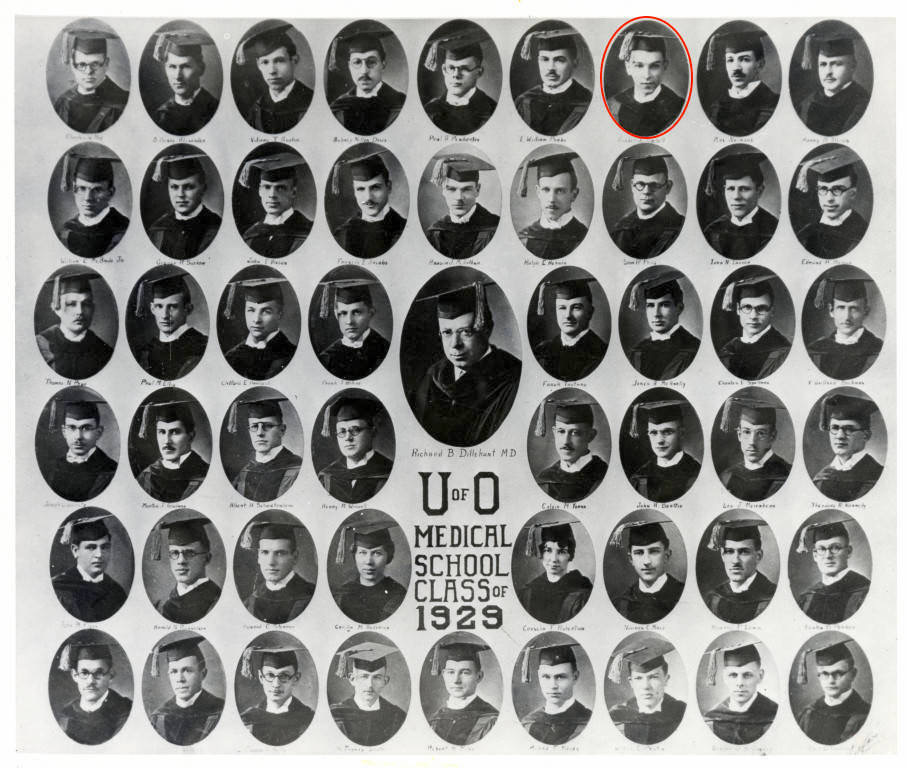
It seems appropriate at this point to explain that Asahel is a rising star in the medical world in the United States. The University of Wisconsin in the 1930s was a large, important university and the medical school was research oriented in an age of non-research medical schools. Later at the Touro Infirmary at Tulane University in New Orleans, he would be in the medical news almost monthly. There are no fewer than 237 newspaper articles about Asahel in the New Orleans newspapers during his tenure there. These are generally articles regarding medical issues of a developing country. Lelah unfortunately takes a back seat and shows up in the gossip columns as Dr. Hockett’s wife attending a special tea at some social gadfly’s house.
In 1928-29 Asahel travels to the University of Wisconsin to do his internship at Wisconsin General Hospital and makes a favorable impression on the staff there.
In 1930-31 Asahel has a brief medical practice in Enterprise, presumably with his father Dr. CT Hockett. I believe Asahel was probably bored with this and moved on quickly.
In 1931 Asahel receives an important appointment to be Head Resident Doctor at Wisconsin General Hospital. He stays in this post until 1935. Chief Resident Physician is one of the more important positions in any teaching hospital and at such a young age it is even more impressive.
Asahel appointed Chief Resident Physician 1931
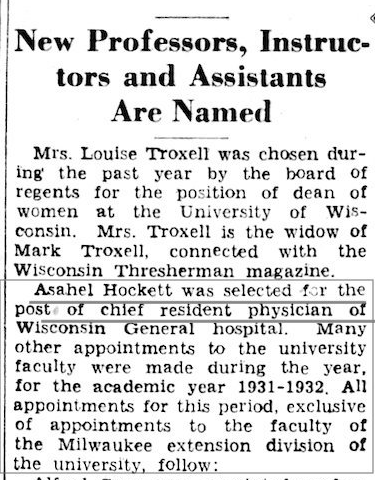
In 1934 a very important event occurs in Lelah and Asahel’s lives, daughter Sally is born. Sally would spend her years growing up in the urban social/medical environments of Madison, New Orleans, and Seattle but she would not experience the rural roots of Wallowa County as a child like her parents.
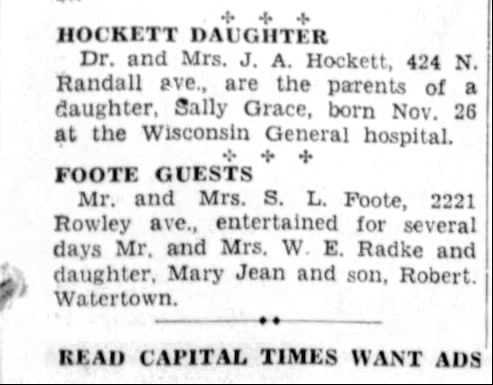
The family remains in Madison from 1931 until 1935 when Asahel accepts the position of Superintendent at Touro Infirmary, Tulane University, New Orleans.
Touro Infirmary was established in 1852 by Judah Touro a Jewish philanthropist to provide care for slaves and indigents of all races. It has been one of the major hospitals in New Orleans since its founding. Asahel serves as superintendent from 1936 through 1943. The Touro period is the height of Asahel’s medical career.
Dr. A.J. Hockett announcement, 1935
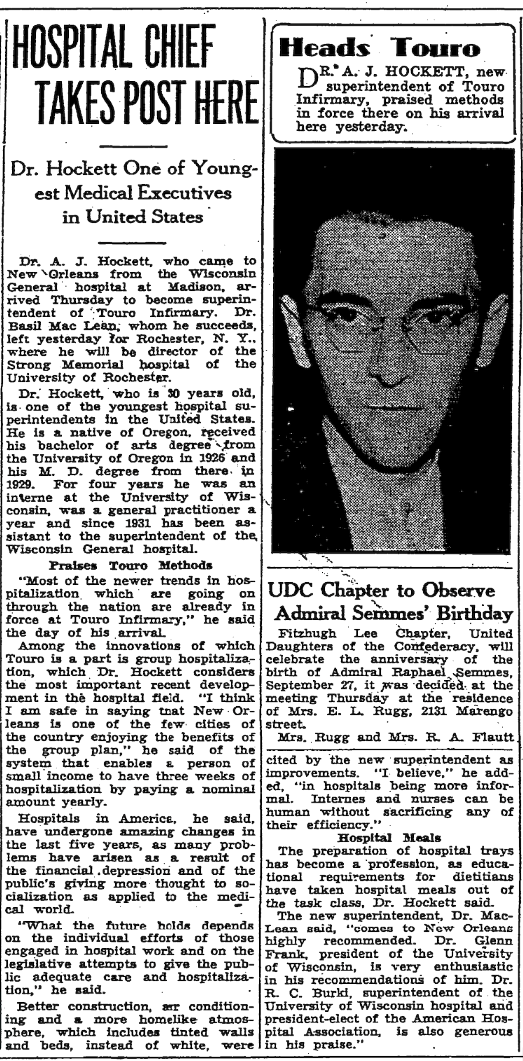
Dr. Asahel Hockett with his staff and interns at Touro, 1936; Asahel is in the middle
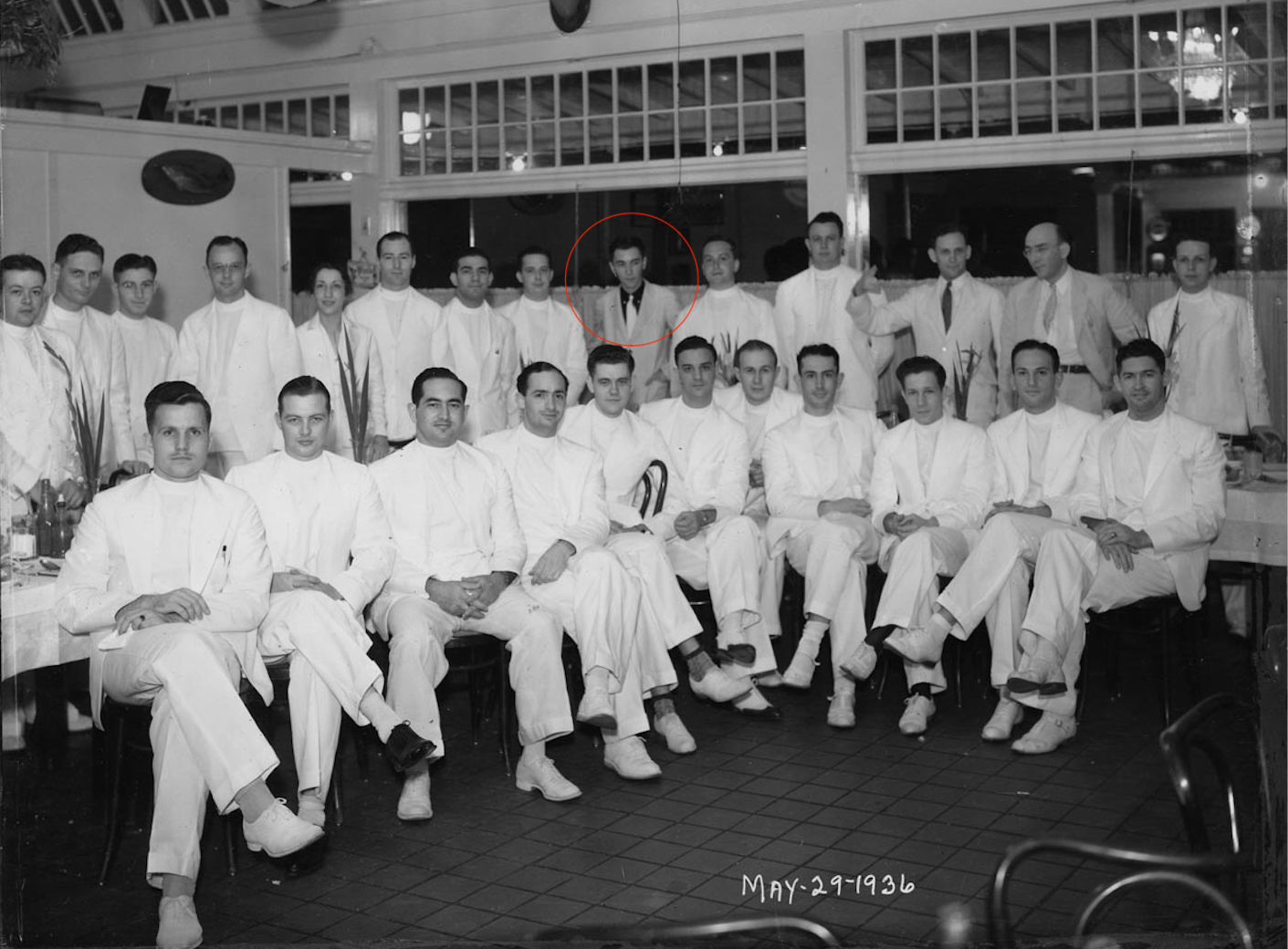
Touro Infirmary Building
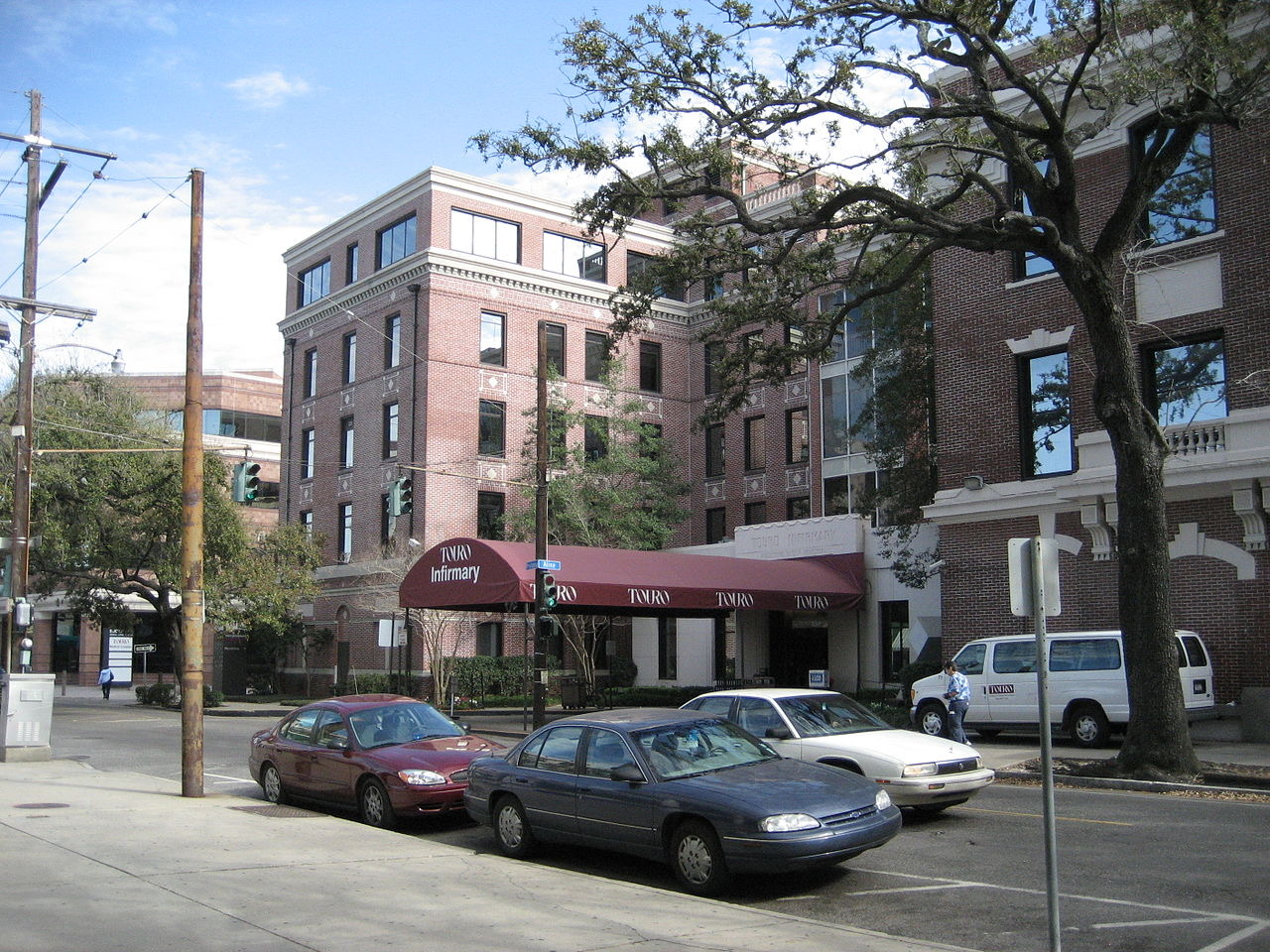
The New Orleans period is a time of many high profile medical positions for Asahel across the country.
• Chairman of the Louisiana Hospital Association, 1937-39
• Delegate to International Hospital Association Convention, England, 1937
• President Southeastern Hospital Conference, 700 member hospitals
• Various positions involving advising military medical facilities
He was also prominent in various issues of the day and these are noted in newspaper headlines.
• Recommended in a national news article that women become doctors (against prevailing wisdom)
• Wrote an article on marijuana cigarettes threatening New Orleans (widely reprinted nationally)
• Delivered a speech at American Hospital Assoc. convention regarding “Should Babies be Born at Home or in a Hospital”; this involved a national public medical debate with another doctor.
We don’t know why Asahel decides to leave Louisiana and take a position at Harborview Hospital in Seattle in 1944, but it begins a stormy period for he and Lelah. This is before the 1946 hotel fire in Chicago so physical pain is not yet an issue for him.
Appointment as Superintendent of Harborview County Hospital in Seattle, 1944

By 1945 Asahel will be in the middle of a local corruption scandal involving Albert Rosellini a local politician and president of the Board of Trustees for the hospital. Rosellini would go on to become governor of Washington State in the 1950s. There are many articles about this scandal in the papers, however, the main charge against Asahel is that he decides to purchase higher quality medical supplies from outside of Seattle and this offends local vendors who want the contracts and who are giving financial support to Rosellini. The hospital is embroiled in controversy before Asahel arrives:
In this article the Municipal League of Seattle urges the “Hospital Board be replaced in order to take the hospital out of politics” including Rosellini, and requests Asahel be given full authority to manage the hospital. (Image is blurry)
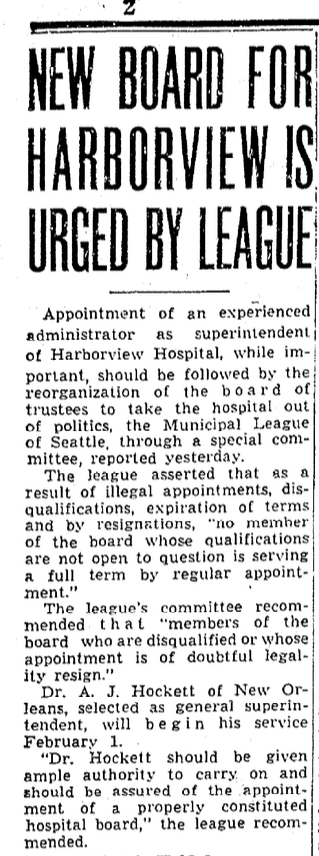
By 1945 there are several long articles describing charges against Asahel along with his replies. However, Asahel seems to have had enough of political infighting (worse than New Orleans, hard to imagine), and offers to resign.
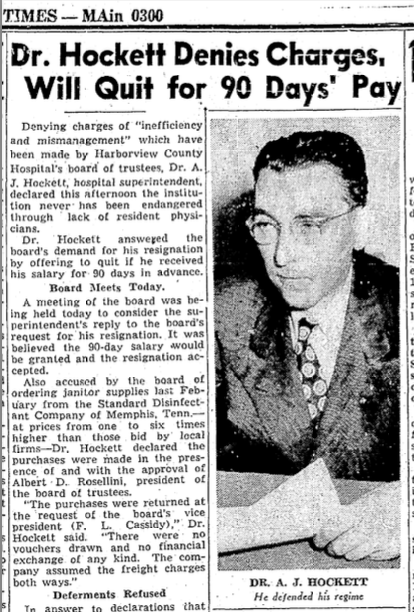
In 2013 the Seattle Times publishes a long article about Rossellini’s corruption including an FBI file kept on him which details his contacts with Frank Colacurcio Sr. A local mobster and the article recounts Rosellini’s demands for campaign contributions to secure bank charters and other government favors.
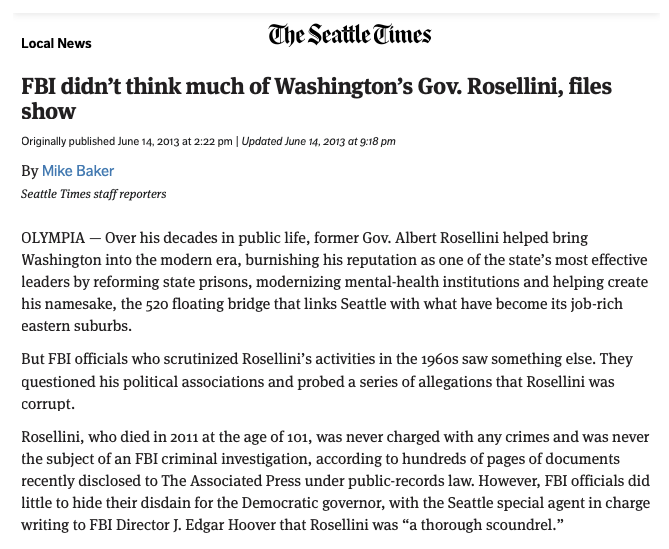
Asahel took the wrong job at Harborview in his move to come back to the Northwest.
While Asahel is at Harborview there is one other interesting story involving the mental health commitment of screen actress Fannie Farmer. Asahel ends up being the doctor who signs her commitment documents. Here is copy from the Seattle newspaper article:
Frances Farmer Again Ordered to Steilacoom
Frances Farmer, former University of Washington student who rocketed to fame as a film actress, reached the end of a turbulent trail yesterday in a small, plainly furnished room at King County Hospital where the county sanity commission ordered her recommitted to Western State Hospital at Steilacoom.
Miss Farmer was ordered back to the state institution, where she was confined from March until July, 1944, at the conclusion of a hearing presided over by Superior Judge Hugh C. Todd.
Took It Quietly
The blonde former film actress took the news of her recommitment quietly, Dr. A. J. Hockett, superintendent of King County Hospital where the county commission hearing was held, said. She did not appear before the hearing but was examined during it by hospital psychiatrists, Dr. Hockett explained.
The psychiatrists found her resting in the King County Hospital room where she has been since last week when her mother, Mrs. Lillian V. Farmer, 2636 47th Ave. S.W., filed a sanity complaint against her. She was reading and made no objection to the examination, Dr. Hockett said.
The complaint filed by Mrs. Farmer charged the young actress, identified by her married name as Mrs. F. E. Anderson, was not safe to be at large.
Twice Disappeared
After her release from Western State Hospital last summer, Miss Farmer spent some time recuperating on the ranch of an aunt near Reno, Nev. However, after she twice disappeared from the ranch and was found only after extensive search, she returned to her mother’s home in Seattle.
The filing of the insanity complaint followed another disappearance of a few hours May 6 when her mother sought police aid in finding her daughter. The young woman’s father is E. M. Farmer, veteran Seattle attorney.
Article appeared in The Post-Intelligencer – May 22, 1945
Provided by Ulrich Fritzsche M.D.
This was a period when involuntary commitment was being question as a medical practice in the media.
In 1945 Asahel moves on from Harborview.
Asahel seems to be not employed with any medical organization in early 1946 but does attend a championship bridge card tournament in Chicago in June. At the time he is living in a suburb, Glencoe, Ill. This is the most fateful month of Asahel’s life, and of course in Lelah’s life too. During the tournament he his staying in the fancy La Salle Hotel in downtown Chicago.

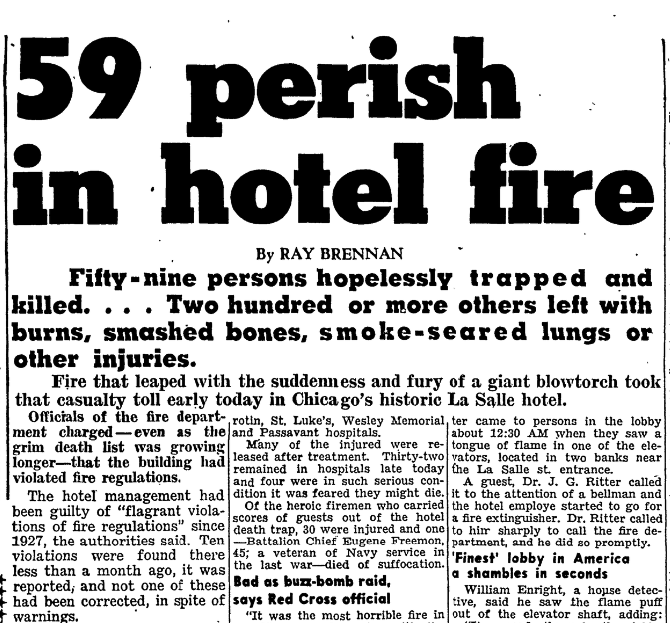
At 12:15 a.m. On June 5th 1946 while 900 guests are sleeping a fire started in the cocktail lounge on the lower floor and quickly engulfed the lower floors which had extensive varnished wood paneling (very explosive material). Ultimately sixty-one people die and many are badly burned including Asahel. It is one of the worst fires in Chicago in the 20th Century and results in a complete change to city fire codes. This story has a great many listings, too many for this narrative.
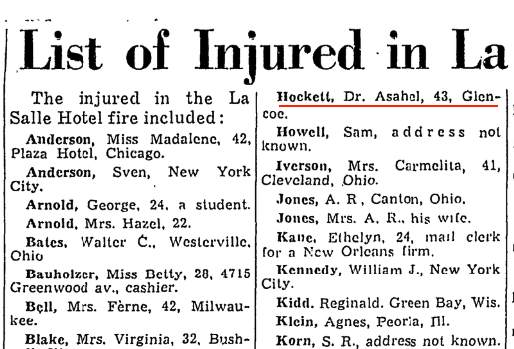
Here is Wade’s recollection of what happened to Asahel from Jay or Roberta….
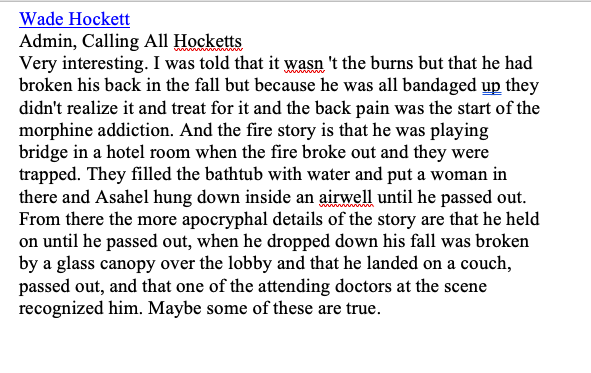
My recollection from Dad is that the skin grafts for the burns were painful and went on for years and that contributed to taking morphine to deal with it. Regardless of the details, Asahel would be in pain the rest of his life and would use both pain killers and alcohol to deal with it. The beginning of addiction and a long downward spiral.
Asahel must have convalesced for many months and meanwhile we don’t hear a word about Lelah.
The next medical position occurs in Sept. 1946 when he accepts a position as Director of Wilmington General Hospital in Delaware. An amazing recovery from the fire in June. Asahel serves in this position at Wilmington until Sept. Of 1950. During this time there is a severe polio outbreak across the US and Wilmington is no exception. The Salk polio vaccine was not widely available until 1955. Even Wallowa County was caught up in the fear of the spreading disease.

In 1950 Asahel resigns from Wilmington General Hospital.
By December of 1950 he has been hired as the Director of the Madera County Hospital (near Fresno, Calif.) but looses that job after one month due to an arrest for driving while drinking. The post-Wilmington time is the beginning of a period of instability for Asahel and Lelah.
Early in 1951 the family moves to Wallowa County where Asahel takes over as administrator of the new Wallowa Memorial Hospital.
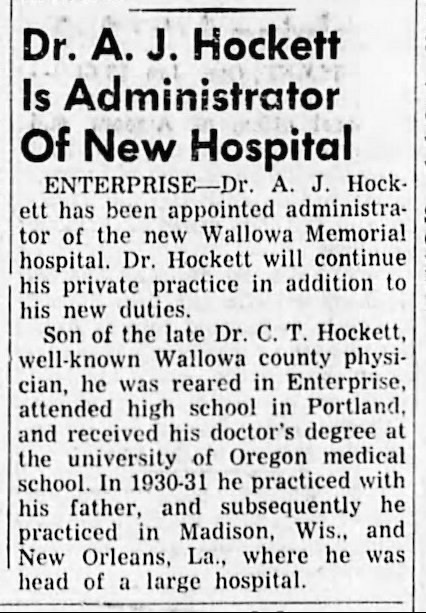
However, by the fall of 1951 Asahel has quit the job with Wallowa Memorial stating that the patient load was insufficient to provide the necessary revenue to support the hospital. Thereafter there is a turbulent period for the hospital in attempting to regain its reputation as a financially stable organization.
After this he spends his time in a small clinic he owns in Wallowa, practicing general medicine. Generally news of the couple is mostly social (card parties, visiting) except in 1956 Asahel is admonished by a grand jury in the County for removing a dead body without the coroner’s permission. Somewhat of an unexpected news subject. In the same year Lelah is bringing her step father, Howard Evans, home from Portland on the train and he passes away as the train enters La Grande. An upsetting year for them.
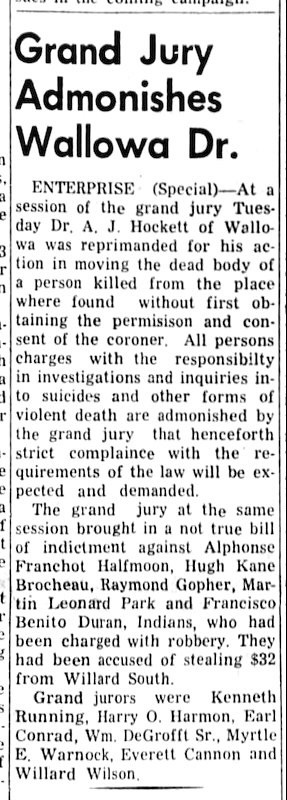

Asahel and Lelah remain in the County through the fifties. Eventually the morphine becomes addicting to the point of interferring with his work and Asahel has his medical license revoked. Sometime in the fifties he spends time at Eastern Oregon Mental Hospital in Pendleton in rehab. In 1959 he has his license restored by the Oregon Board of Medicine and in 1964 the Wisconsin State Board restores his license in that state.
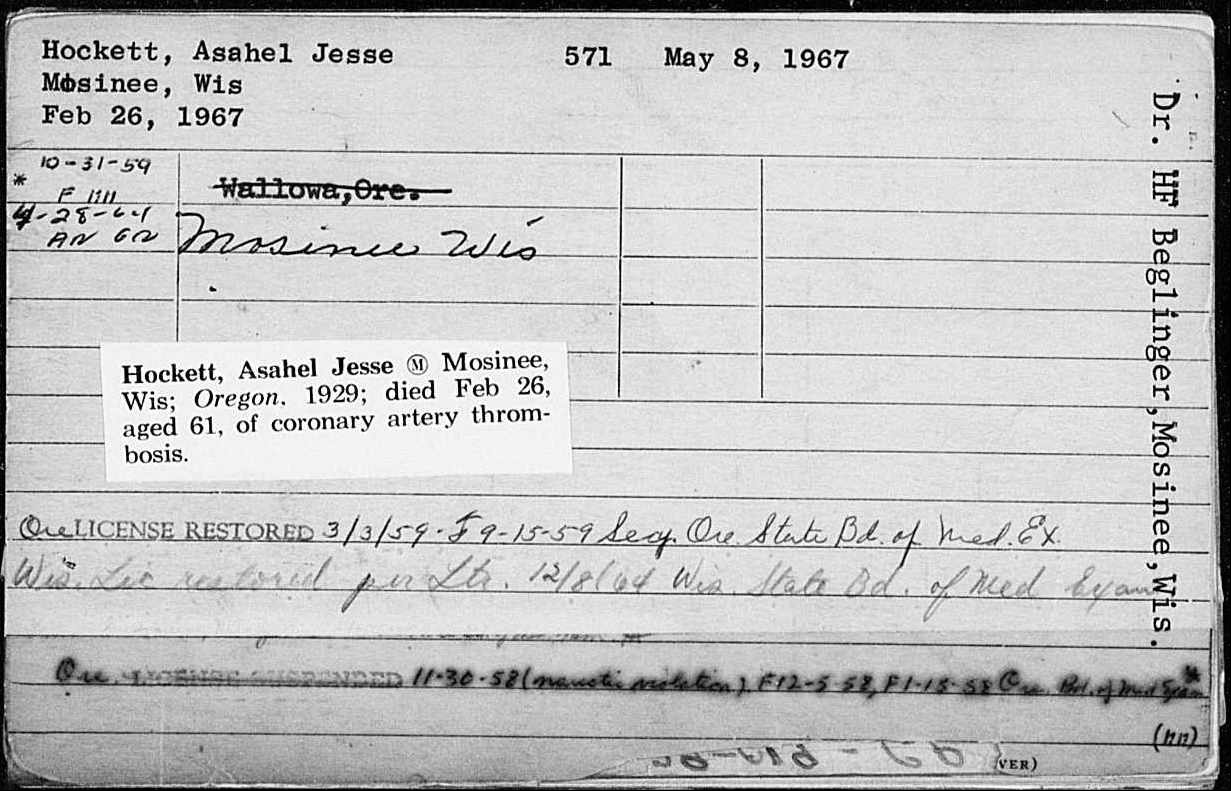
The last time I saw Asahel was in 1962 as a sophomore in high school. Joseph High played a football game at Wallowa and during the game I tore the cartilage in my right knee. At the end of the game my dad took me over to Asahel’s clinic where he put a 3 inch long needle into my knee and filled it with pain killers. My knee was numb until Sunday morning when it hurt like hell.
In 1964 Asahel moves from Wallowa County to Mosinee, Wisconsin to practice in this small town as its only physician. There is no evidence that Lelah goes with him.

Three years later, Asahel passes away in Mosinee and is buried there. I don’t believe there is a headstone in the Enterprise cemetery or any memorial in Wallowa County for either of them.

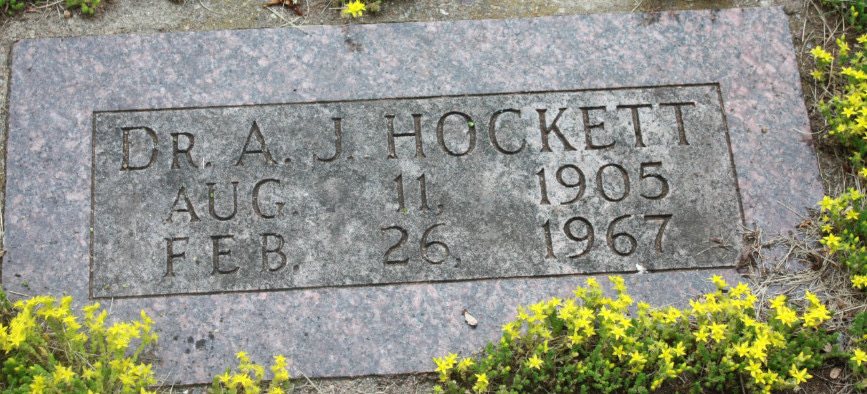
There is no other word about Lelah until she passes away in 1981, within a few months of the death of their daughter Sally. She is living in Portland at the time. There is no record of her grave location.
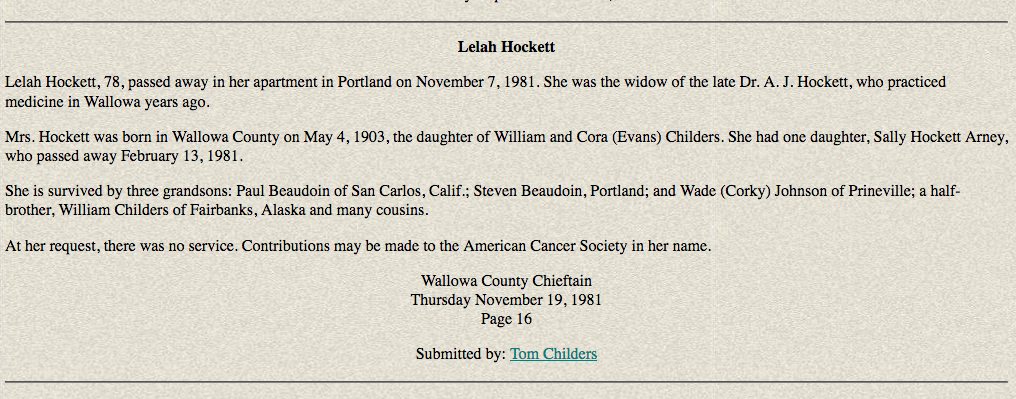
————————————————————————————————————————————————
Asahel and Lelah Narrative Summary-
While this is a sad ending to a long story it is well to remember that both Asahel and Lelah lived eventful lives. For a time during which Americans stayed close to home, they traveled and saw a great deal of America and experience the heady life of the urban medical world. Asahel was a superb physician and was determined to practice up until the very end in a tiny town in Wisconsin. Even in his dark days patients always trusted in his medical knowledge.
Asahel as a young doctor
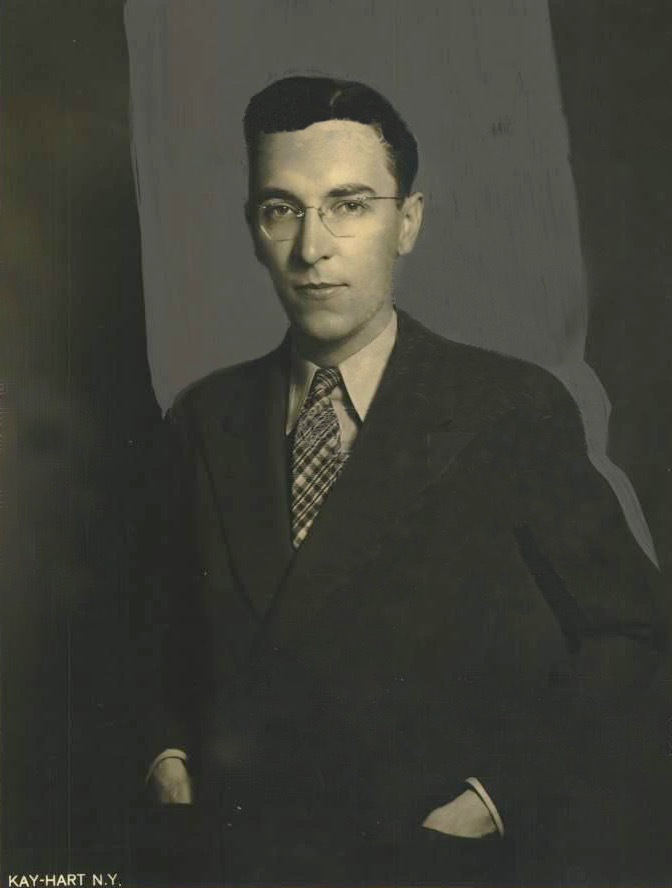
If anyone has a good photo of Lelah, please send it and it will be added to the narrative.